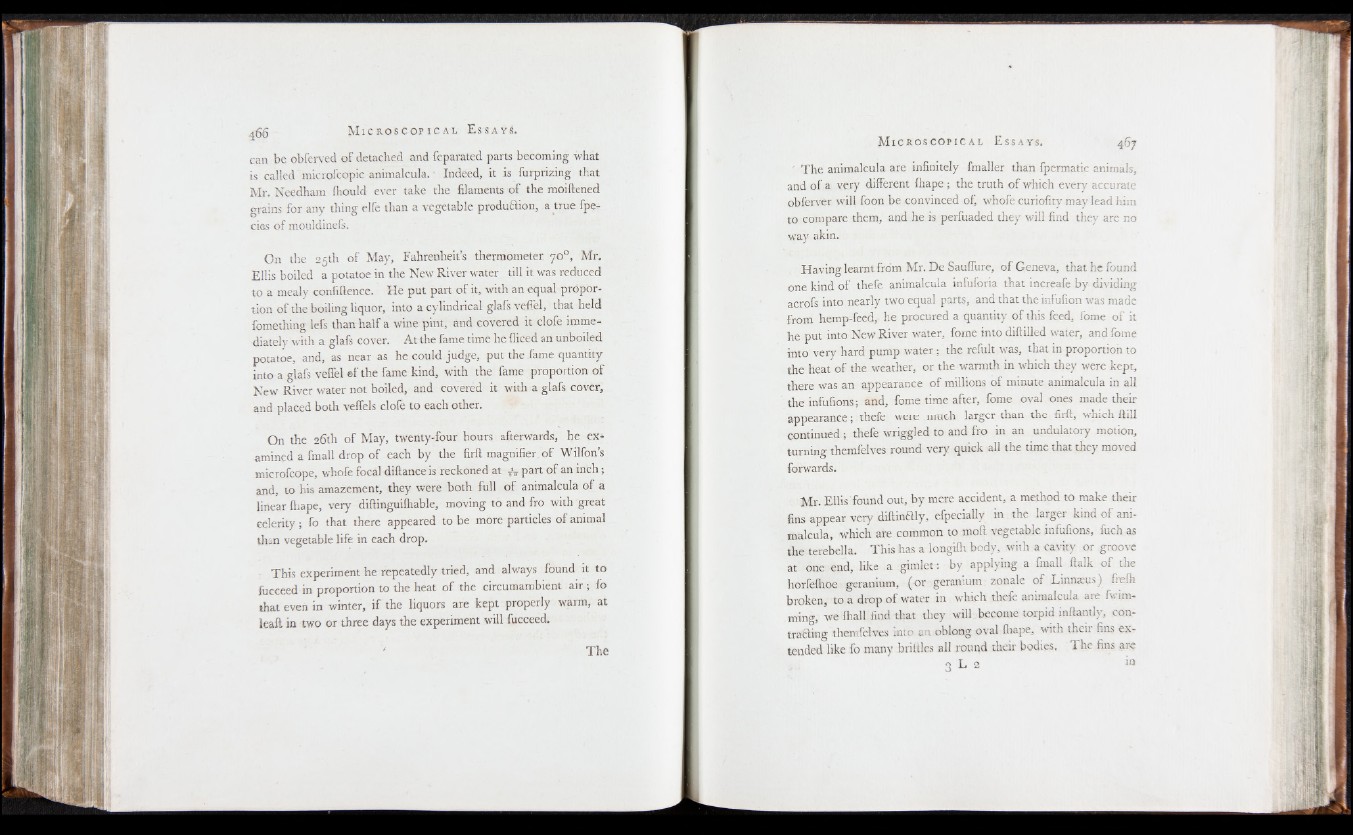
can be obferved of detached and feparated parts becoming what
is called microfcopic animalcula. ■ Indeed, it is furprizing that
Mr. Needham fhould ever take the filaments o f the moiftened
grains for any thing elfe than a vegetable production, a true fper
cies of mouldinefs.
On the 25th of May, Fahrenheit’s thermometer. 70°, Mr.
Ellis boiled a potatoe in the New River water till it was reduced
to a mealy confiftence. He put part of it, with an equal proportion
of the boiling liquor, into a cylindrical glafs veffel, that held
fomething lefs than half a wine pint, and covered it clofe immediately
with a glafs cover. At the fame time he fliced an unboiled
potatoe, and, as near as he could judge, put the fame quantity
into a glafs veffel of the fame kind, with the fame proportion of
New River water not boiled, and covered it with a glafs cover,
and placed both veffels clofe to each other.
On the 26th of May, twenty-four hours afterwards, he examined
a fmall drop o f each by the firft magnifier o f Wilfon’s
microfcope, whofe focal diftance is reckoned at T*„ part of an inch;
and, to his amazement, they were both full of animalcula o f a
linear ffiape, very diftinguilhable, moving to and fro with great
celerity; fo that there appeared to be more particles of animal
than vegetable life in each drop.
This experiment he repeatedly tried, and always found it to
fucceed in proportion to the heat o f the circumambient air ; fo
that even in winter, if the liquors are kept properly warm, at
leaft in two or three days the experiment will fucceed.
The
' The animalcula are infinitely fmaller than fpermatic animals,
and o f a very different lhape ; the truth o f which every accurate
obferver will foon be convinced of, whofe curiofity may lead him
to compare them, and he is perfuaded they will find they are no
way akin.
Having learnt from Mr. De Sauffure, o f Geneva, that he found
one kind o f thefe animalcula infuforia that increafe by dividing
acrofs into nearly two equal parts, and that the infufion was made
from hemp-feed, he procured a quantity o f this feed, fome of it
he put into New River water, fome into diftilled water, and fome
into very hard pump water % the refult was, that in proportion to
the heat o f the weather, or the warmth in which they were kept,
there was an appearance of millions o f minute animalcula in all
the infufions; and, fome time after, fome oval ones made their
appearance; thefe were much larger than the firft, which ftill
continued ; thefe wriggled to and fro in an undulatory motion,
turning themfelves round very quick all the time that they moved
forwards.
Mr. Ellis found out, by mere accident, a method to make their
fins appear very diftinftly, efpecially in the larger kind o f animalcula,
which are common to moft vegetable infufions, fuch as
the terebella. This has a longifh body, with a cavity or groove
at one end, like a gimlet: by applying a fmall ftalk o f the
horlelhoe geranium, (or geranium zonale of Linnaeus) frelh
broken, to a drop o f water in which thefe animalcula are fwim-
ming, we lhall find that they will become torpid inftantly, contrafiling
themfelves into an oblong oval fliape, with their fins extended
like fo many briitles all round their bodies. The fins are
3 L 2 *n